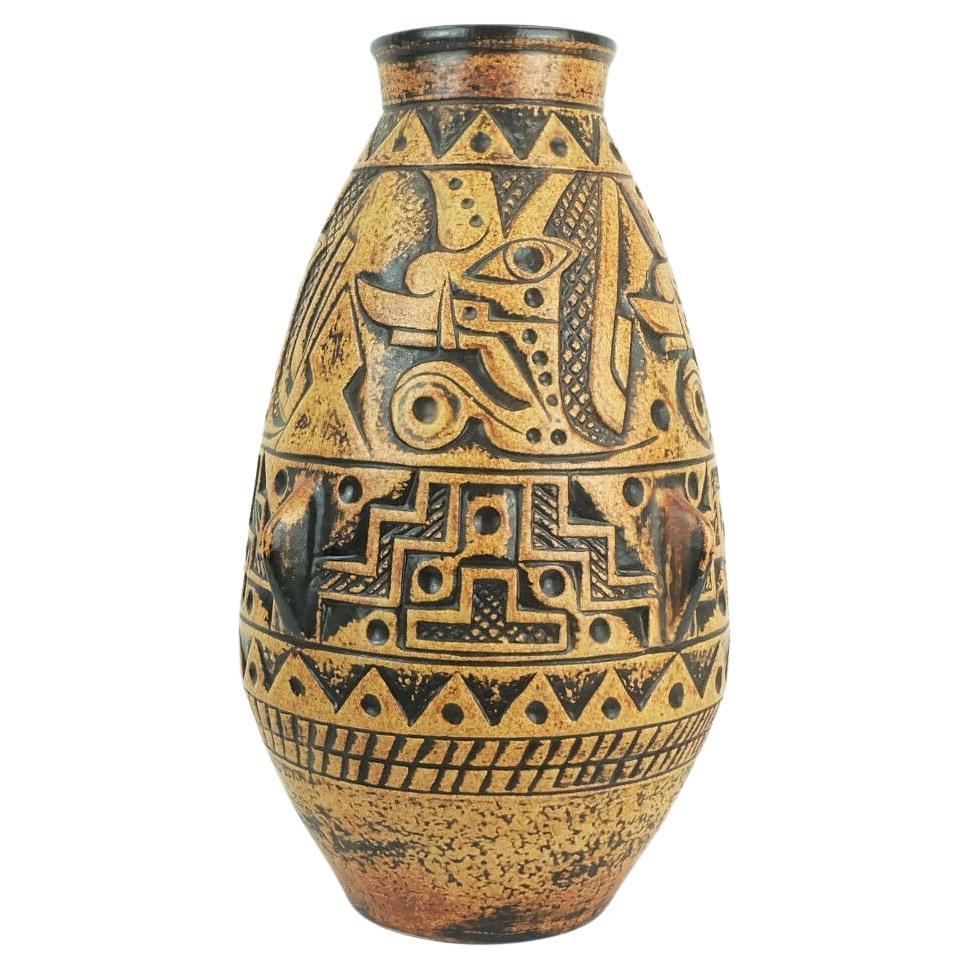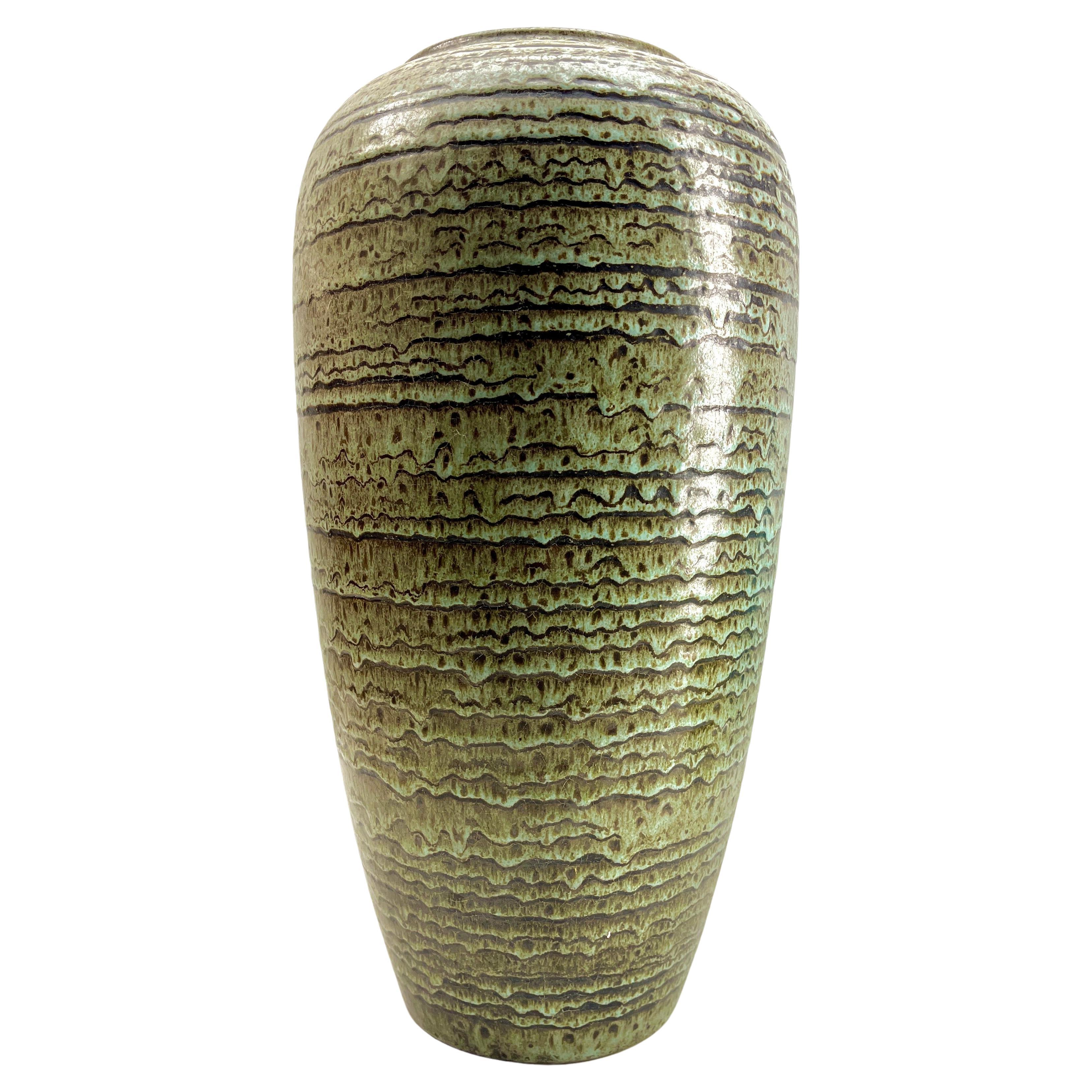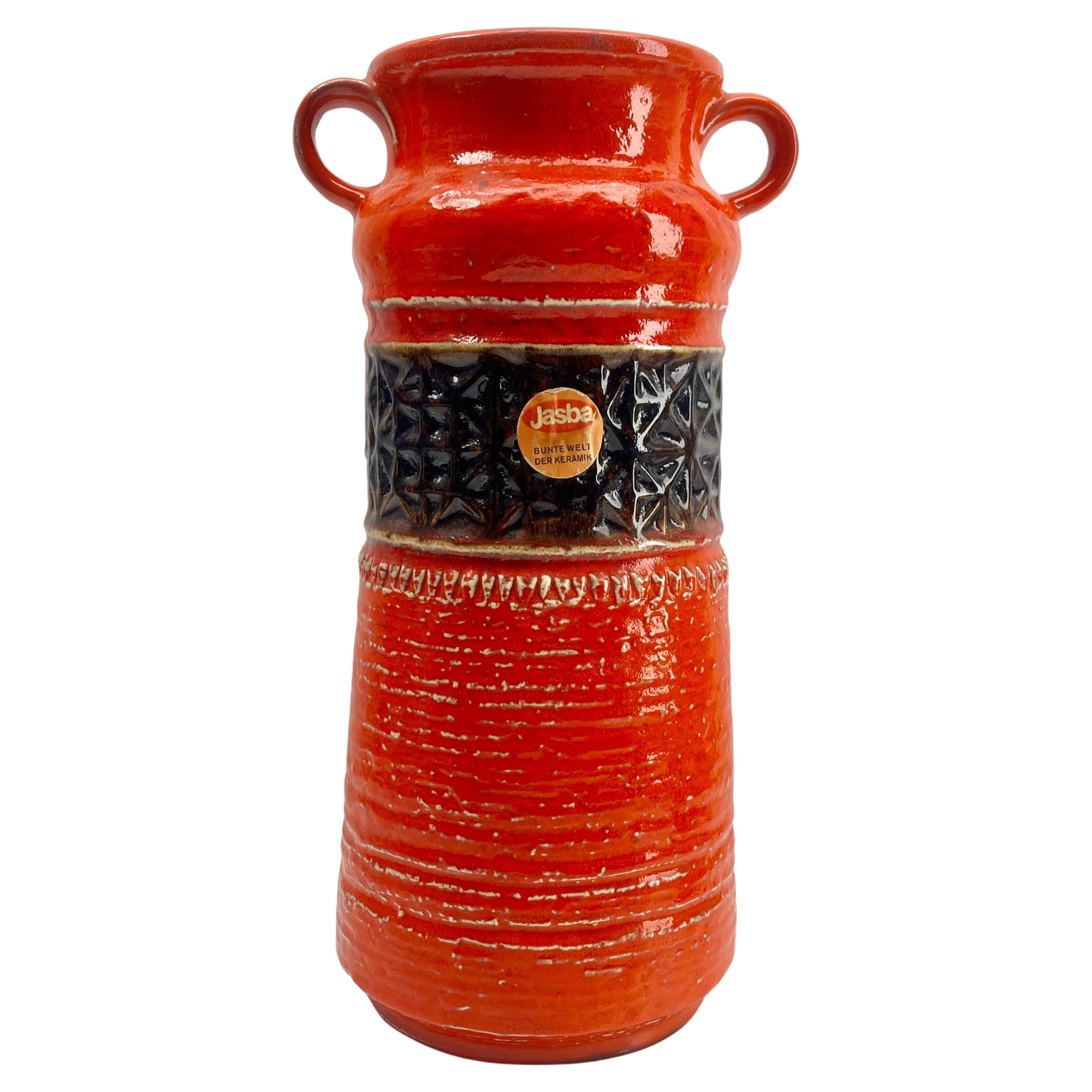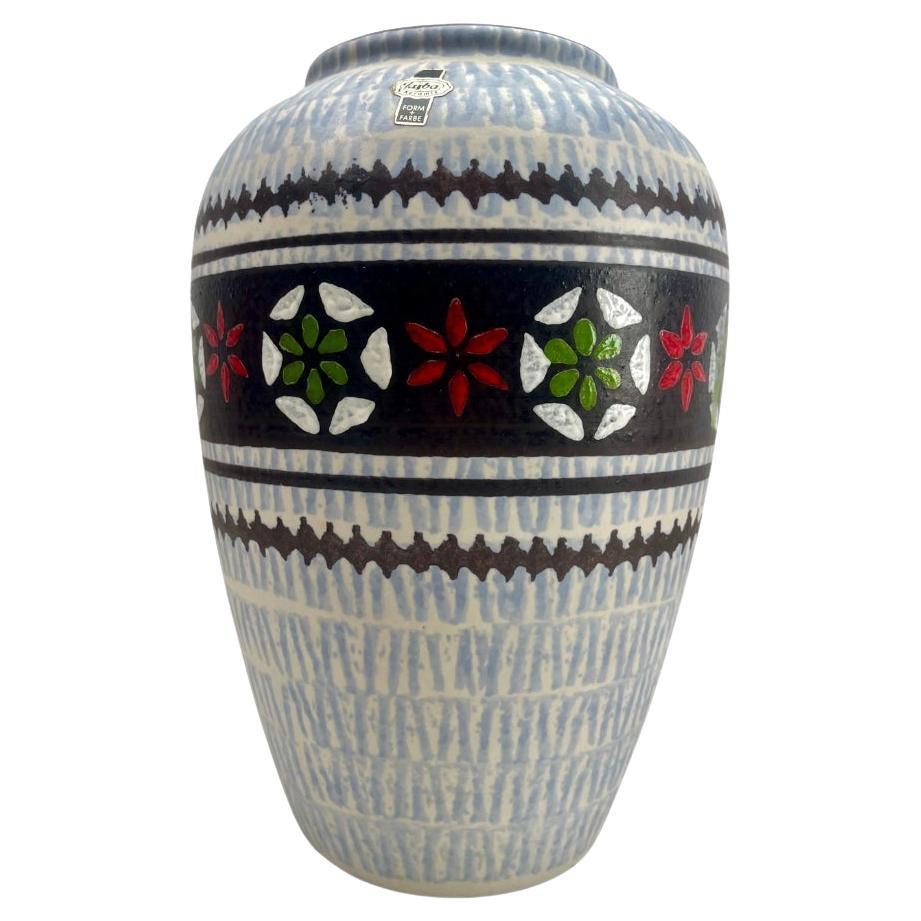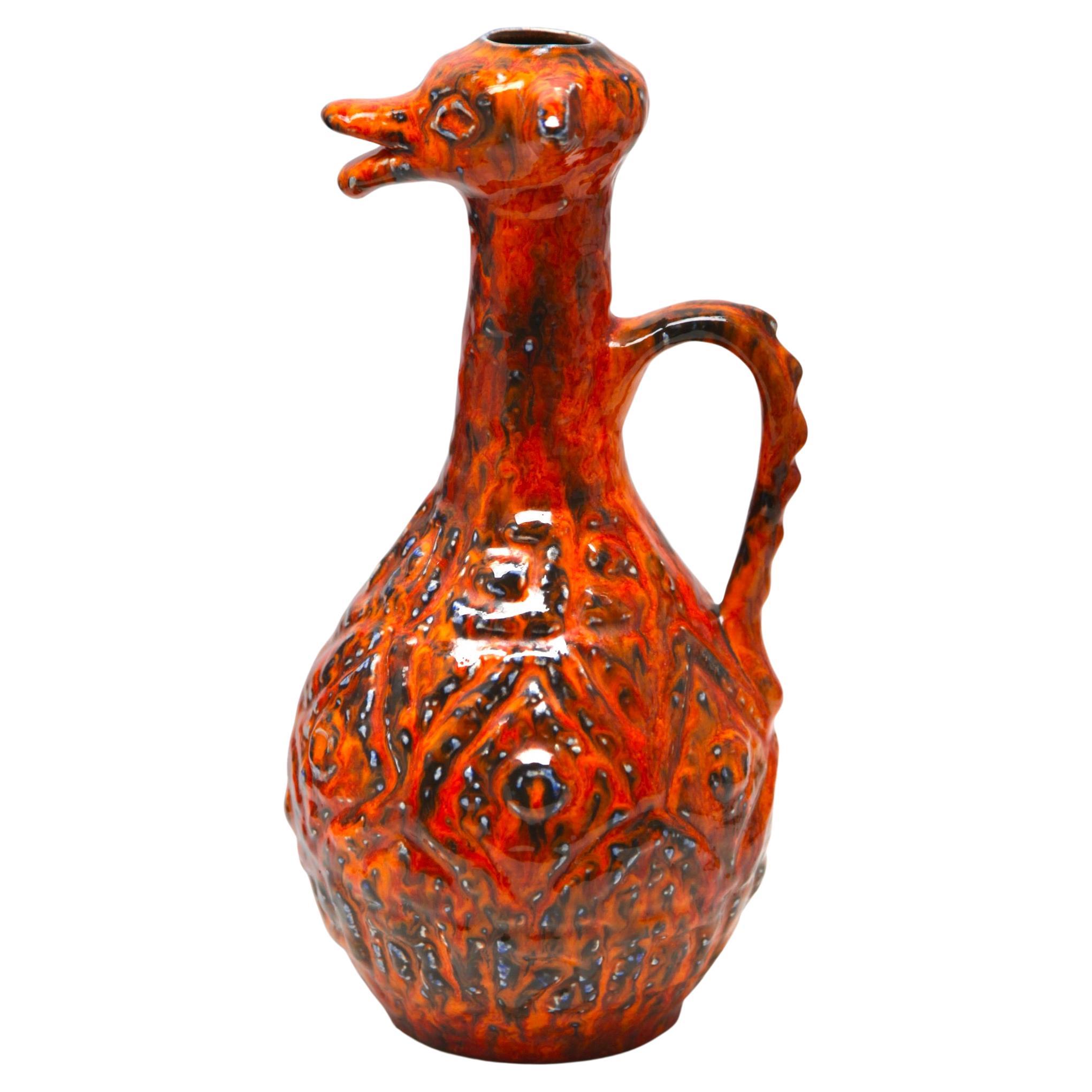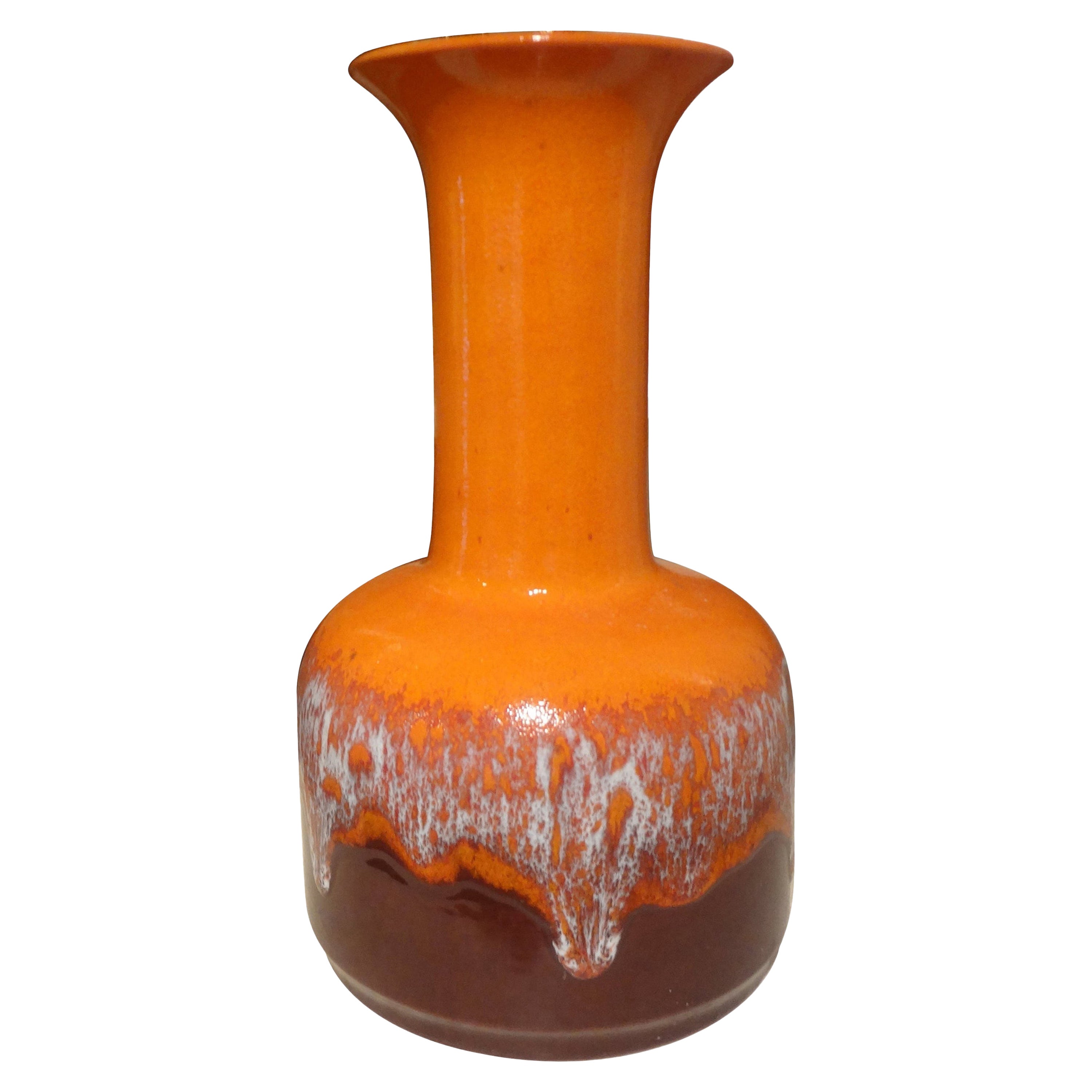Items Similar to rare huge JASBA "AZTEC" FLOOR VASE marked 1 521 45
Want more images or videos?
Request additional images or videos from the seller
1 of 20
rare huge JASBA "AZTEC" FLOOR VASE marked 1 521 45
About the Item
A very rare 'Aztec' relief-décor floor vase from JASBA KERAMIK.
JASBA produced several series of ceramics on themes inspired by ancient civilizations; among the most sought-after today are examples from the 'Aztec' and 'Mexiko' line.
It is quite unusual to find this particular item in the secondary market. Impressed with the maker's mark and mold number on its base - specially this size!
This stupendous vase would make an extraordinary centerpiece with a grand arrangement of flowers sprouting as a crown!
JASBA KERAMIK was founded by Jakob Schwaderlapp in 1926 on a leased property in the small community of Baumbach, today incorporated into the town of Ransbach-Baumbach, in the Rheinland, now the German state of Rhineland-Palatinate, in the heart of the Kannenbäckerland. (The Kannenbäckerland—the potters' land, or more literally the jug-bakers' land—is the site of Europe's largest clay deposit and the home to centuries-old ceramics manufacture.) Schwaderlapp first produced earthenware central-heating systems, but as early as 1928, built a separate factory to accommodate an expansion into domestic wares including terra cotta vases, fruit bowls, and baking dusters. In 1937 glazed ceramics were added. A major fire temporarily interrupted business development in 1938, but the factory was soon rebuilt, and all of the new buildings were equipped with the latest modern technology. Unfortunately, this came about just in time for the outbreak of WWII. JASBA was mostly restricted to contract work for the Wehrmacht (the united armed forces of Nazi Germany) for the duration of the war, but the production of porcelain, stoneware, and ornamental ceramics quickly resumed when the war ended. A steep upward trend followed in the post-war period; the number of employees rose from 80 in 1948 to 480 by 1955. By that time JASBA had grown to be the largest ceramics enterprise in the Westerwald, with a volume of domestic and foreign sales in the seven-digit range, so, when the troubled Porzellanfabrik Niederrhein GmbH in Rees became available in 1957, the decision was made to buy it and convert it to the production of industrial tiles and mosaic wall panels for the building trade. This decision would prove to be one of Schwaderlapp's best.
Meanwhile, the already large range of ornamental ceramics coming out of the parent plant continued to expand. The program was limited to conventional forms and décors until a cautious introduction of modern forms began in 1955. In that year, the décor 'Jaspatina' was introduced, and a year later the very popular crawl glaze 'Cortina' was made available in several color variants. The latter proved to be very successful and remained in the production until the early '60s. At the beginning of 1957, the ceramicist and décor designer Cilli Wörsdörfer joined JASBA KERAMIK following a stint at Ruscha, where she had created the popular 'Domino' and 'Milano' décors (1954). Her colorful, abstract work shook up the previously conventional appearance of JASBA's ornamental ceramics. She struck a special note with the décors 'Tuscany,' 'Udine,' and 'Verona' (1957); she followed these up with 'Ghana' and 'Karo' (1958), all of which are much sought after by collectors of JASBA's '50s-era production.
JASBA's immense repertoire was characterized by diversity. In 1958 alone, 40 different forms of vases were offered in more than 80 sizes and almost 30 different decor variants. In a bid to reach a higher-end market, Schwaderlapp founded JASBA's well-heeled sister company, Ceramano Kunstkeramik W.J. Schwaderlapp KG in 1959. Ceramano would become a powerhouse in its own right with the production of innovative, higher-end forms and glazes, intended to resemble the work of studio potters. Its products were sold in better department stores and speciality shops throughout Europe.
When she married in 1960, Wörsdörfer ended her artistic career, and handed over her position to Christiane Reuter, whose wide ranging 'Bunte Welt der Keramik' (Colorful World of Ceramics) series initiated the introduction of newer stylistic tendencies and bright colorful glazes at JASBA in late 1962. (Reuter is also celebrated as the designer of the iconic 'Acapulco' dinnerware décor for Villeroy and Boch (1967), which remained in continuous production until 1994 and is highly prized by collectors.) JASBA did not do many lava or other textured glazes, but they were especially experimental with shapes and molded patterns. At the end of the 1962 the last typical shapes and decors of the previous decade were retired. The production of decorative ceramics began to decrease at the beginning of the 1970s. In 1981 the focus of production shifted exclusively to the company's extremely successful line of architectural tiles. The business still operates today as Jasba Mosaik.
Design Period – 1970-1979
Country of Origin – WEST GERMANY
Maker – JASBA KERAMIK
Attribution – MARKED : " 1 521 45 "
Materials – CERAMIC
Condition – VERY GOOD (no defects; may show very slight traces of use)
Height (cm) – 45.0
Diameter max (cm) – 35.0
Diameter inner rim (cm) - 15.5cm
Weight: 4050 g
- Creator:Jasba (Maker)
- Dimensions:Height: 17.72 in (45 cm)Diameter: 13.78 in (35 cm)
- Style:Mid-Century Modern (Of the Period)
- Materials and Techniques:
- Place of Origin:
- Period:
- Date of Manufacture:1972-1979
- Condition:
- Seller Location:Kumhausen, DE
- Reference Number:1stDibs: LU8587235140432
About the Seller
5.0
Gold Seller
These expertly vetted sellers are highly rated and consistently exceed customer expectations.
1stDibs seller since 2023
8 sales on 1stDibs
Typical response time: 2 hours
- ShippingRetrieving quote...Ships From: Bodenkirchen , Germany
- Return PolicyA return for this item may be initiated within 10 days of delivery.
More From This SellerView All
- turquoise lava glazed RUSCHA FLOOR VASE 60s 70s hand-thrown marked G.- 863-40By RuschaLocated in Kumhausen, DEbeautiful FLOOR VASE attributed to / most probably by RUSCHA KERAMIK RUSCHA KERAMIK was launched in 1948 when Rudolf Schardt assumed the management of Klein & Schardt, his father Georg's ceramics factory in the town of Rheinbach, located near Bonn in the German state of North Rhine-Westphalia. (RUSCHA is a syllabic abbreviation of his name.) The timing of the re-founding ensured that the company was in a good position to benefit from Germany's post-war growth boom. RUSCHA KERAMIK became a leading manufacturer during the "golden age" of Western German ceramics and is credited with some of the era's key developments. It produced some very successful and innovative forms and glazes, including the 'Vulcano' décor (Otto Gerharz, 1951)—which heralded the move towards thick, dripping fat-lava glazes—and the iconic no. 313 (Kurt Tschörner, 1954), probably the period's most famous shape. Hans Welling, Adele Bolz, Heinz Siery, and Cilli Wörsdörfer were among other notable designers to work for RUSCHA. RUSCHA KERAMIK was celebrated for exquisite wall plates, plaques, and tiles—manufactured for both indoor and outdoor applications—as well as its high-quality vases. Specimens from the 1970s will frequently exhibit remarkable lava and volcanic glazes. When RUSCHA closed its factory in 1996, Scheurich acquired many of its designs and molds; distinctive silver RUSCHA labels were sometimes applied to the subsequent production. Notes on identification: White clay was used practically exclusively. The rare examples made with red-brown clay are thought to date from periods when normal supply sources ran out. Embossed and incised base-numbering was used for vessels. If a vase was made in more than one size, a single digit indicating relative size followed the form number. Low form numbers (< 100) were sometimes preceded by a letter. Like a few other manufacturers, RUSCHA KERAMIK occasionally recycled form numbers, a cause of distress for some collectors. Pieces were never molded with "Germany" or "West Germany." Manufacturer most probably RUSCHA Design Period 1965 to 1975 Production Period 1965 to 1975 Country of Manufacture Germany H / height: 40cm ~ Gew. / weight: 2950grs DM max / diameter max : 16,5 cm ~ DM oben / diameter inner rim: 8.8cm MARKED: marked G...Category
Vintage 1960s German Mid-Century Modern Vases
MaterialsPottery
- SCHEURICH RED 70s FAT LAVA FLOOR VASE West Germany 1970s marked 284-47By Scheurich KeramikLocated in Kumhausen, DEa striking RED FAT LAVA FLOOR VASE no. 284-47 by SCHEURICH SCHEURICH had its origins in a joint venture launched in 1928 by Alois Scheurich and his cousin Fridolin Greulich in the small town of Schneeberg near the Czech border in Saxony—wholesaling glass, porcelain, and ceramics. The business was moved to the market community of Kleinheubach in the northeast corner of Bavaria in 1938, and ten years later the partners began producing household ceramics of their own, selling them under the name Scheurich & Greulich. In 1954 the partnership was dissolved, and Alois founded Scheurich GmbH & Co. KG to continue production on his own. The celebrated designer Heinz Siery was recruited in 1955 as Scheurich’s lead form designer, but in addition to an extensive range of shapes, he was also key in helping the company develop a successful overarching production strategy, which was to produce a wide array of simple forms that could be produced cheaply and decorated in a great variety of glazes. This resulted in a range of pieces that were both varied and economically adaptable. The approach proved altogether successful and led to Scheurich’s hegemony beginning in the late 1960s. The company's strategy of keeping its prices low combined with an enormous range of attractive designs resulted in millions in sales and the designs were adapted twice a year to the changing tastes of the public. Scheurich mainly made vases and flowerpots but also produced ashtrays, piggy banks, candle stands, beer mugs, buffet clocks, wall reliefs, and Christmas tree holders...Category
Vintage 1970s German Mid-Century Modern Vases
MaterialsPottery
- German Floor Vase 50s 60s huge (50cms) sgrafitto Siershahner FeinsteinzeugfabrikBy Sawa CeramicLocated in Kumhausen, DEFLOOR VASE Siershahner Feinsteinzeugfabrik DEKOR CAPRI 1950s Ritzdekor (sgrafitto) A huge 50s or 60s studio quality 'Klinker' floor vase nr. 54/50 with an sgraffito decor designed ...Category
Vintage 1960s German Mid-Century Modern Vases
MaterialsPottery
- Carstens Tönnieshof German Floor Vase 60s 70s huge (50cms) cloud green glazeBy Carstens TönnieshofLocated in Kumhausen, DEHUGE FLOOR VASE cloudy green glaze Manufacturer CARSTENS TÖNNIESHOF Design Period 1968 to 1978 Production Period 1968 to 1978 Country of Manufacture Germany H / height: 52cm ~...Category
Vintage 1970s German Mid-Century Modern Vases
MaterialsPottery
- Dümler und Breiden German Floor handle Vase 70s huge (40cms) clouded overglazeBy Dümler & BreidenLocated in Kumhausen, DEHUGE FLOOR VASE cloudy brown / blue glaze Manufacturer DÜMLER & BREIDEN Production Period 1968 to 1978 Country of Manufacture Germany H / height: 40cm ~ Gew. / weight: 4250g...Category
Vintage 1970s German Mid-Century Modern Vases
MaterialsPottery
- German Studio Keramik Floor Vase archaic amphora 60s huge & heavy (51cms 11kg )Located in Kumhausen, DEBESPOKE HUGE & HEAVY STUDIO KERAMIK FLOOR VASE - ARCHAIC AMPHORA amazing blue/brown luster overglaze Manufacturer unknown Design Period 1968 to 1978 Production Period 1968 to 19...Category
Vintage 1970s German Arts and Crafts Vases
MaterialsPottery
You May Also Like
- huge and rare mid century FLOOR VASE anubis jasba model N 312 11 5By JasbaLocated in Mannheim, DEVery beautiful and rare mid century ceramic floor vase. Manufactured by Jasba Keramik in the 1960s to 70s. Relief decor "Anubis" in ochre, brown and black. Model N 312 11 55. Dimen...Category
Vintage 1960s German Mid-Century Modern Vases
MaterialsCeramic
- Vintage Vase Marked W Germany Label Jasba Ceramic, Excellent ConditionBy Jasba, West German PotteryLocated in Verviers, BEThese original vintage Jasba vase was produced in the 1970s in Germany. It is made of ceramic pottery. The bottom are marked the vase series number 585-40 Handarbeit. Straight forwar...Category
Mid-20th Century German Mid-Century Modern Jars
MaterialsCeramic
- Vintage Vase Marked W Germany Label Jasba Ceramic, Excellent ConditionBy Jasba, West German PotteryLocated in Verviers, BEThese original vintage Jasba vase was produced in the 1970s in Germany. It is made of ceramic pottery. The bottom are marked the vase series number 136-26 Handarbeit. Straight forwar...Category
Mid-20th Century German Mid-Century Modern Jars
MaterialsCeramic
- Vintage Vase Marked W Germany Label Jasba Ceramic, Excellent ConditionBy Jasba, West German PotteryLocated in Verviers, BEThese original vintage Jasba vase was produced in the 1970s in Germany. It is made of ceramic pottery. The bottom are marked the vase series number N 10111 35 Handarbeit. Straight fo...Category
Mid-20th Century German Mid-Century Modern Jars
MaterialsCeramic
- Jasba Vase Vintage W-Germany, 1960sBy JasbaLocated in Verviers, BEA classic 60s design. Of Fat lava handled vase in the classic sixties decor; with a rough glaze of dark earth-colour From the Jasba W-Germany. Hand decorated glaze. I have nev...Category
Vintage 1960s German Mid-Century Modern Vases
MaterialsCeramic
- West German Glazed Ceramic Vase by JasbaBy JasbaLocated in Houston, TXWest German glazed ceramic vase by Jasba. This stunning orange, cream and brown midcentury West German drip glaze vase. Great selection of md century West G...Category
Vintage 1960s German Mid-Century Modern Vases
MaterialsCeramic
Recently Viewed
View AllMore Ways To Browse
Terra Cotta Floor Vase
W Germany Jug Vase
Retro 60s Bathroom Decor
W Rees
Vintage Stoneware Jug
West German Jug
West Germany Jug
Vintage West German Vase European
Aztec Pottery
Terra Cotta Jugs
Mosaik Vintage
Clobbered Vase
Glass Handbag Vase
Lalique Grasshopper
Loetz Creta
Moretti Satinato
Murano Glass Owl Vase
Murano Owl Vase
